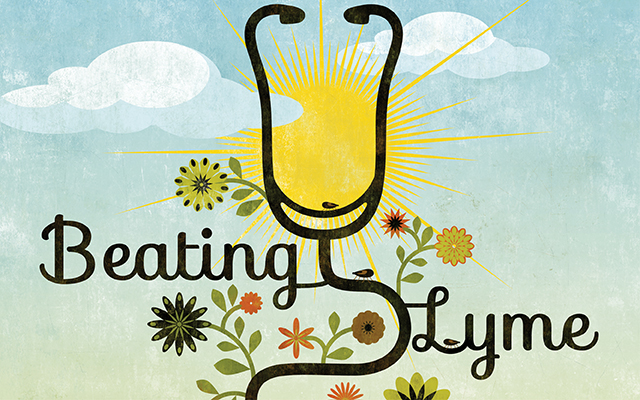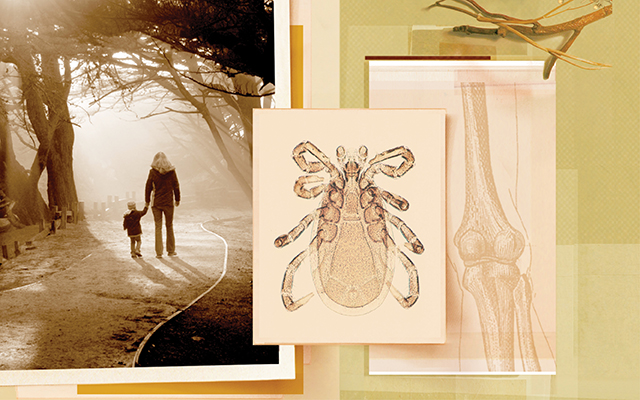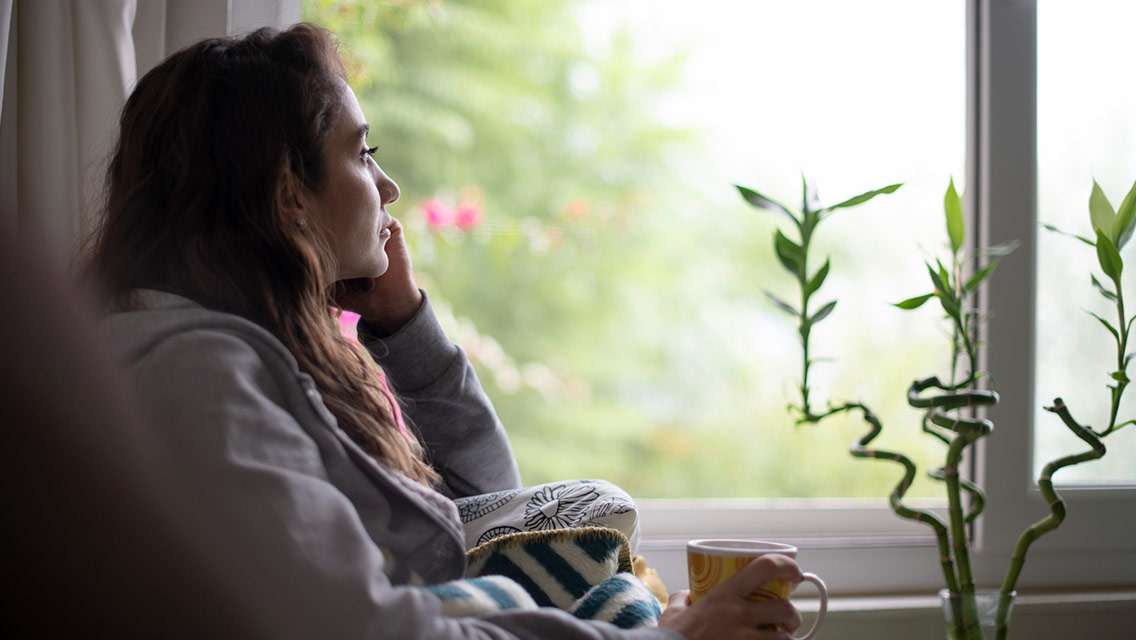Katina Makris was living her dream when life derailed. A natural-medicine practitioner with a flourishing career, she had a passionate marriage, a young son she doted on, and a home she had lovingly restored in the New Hampshire woods. But slowly she began to slip.
First, in June 2000, there was an inkling of muscle pain and fatigue. A few months later, she experienced a crippling migraine, and her arms and legs felt numb. The symptoms only got worse. At night she was engulfed in drenching sweat. Her brain became sluggish and confused. The days were a blur of exhaustion and pain. Eventually, she required a wheelchair and was so sick she had to give up her practice.
Unable to care for her child, she hired an au pair. Between trips to doctors and naturopaths, she spent most of her time in bed. Her marriage crumbled, and divorce was followed by financial struggle and more years in bed.
Five years into this devastating slide, after visits to teaching hospitals and myriad other physicians and practitioners, Makris happened to consult a well-known nutritionist. “He took one look at me and said, ‘I think you have neurological Lyme disease,’” she recalls.
That hunch was confirmed by lab tests, which came back positive for the infectious agent of Lyme disease, a spiral-shaped bacterium, or spirochete, transmitted by the bite of a black-legged tick.
Makris also tested positive for Babesia, a malaria-like blood parasite often inhabiting the same ticks. “I was never so relieved and furious at the same time,” Makris recalls. How could someone immersed in the healthcare profession herself fall so disastrously between the cracks?
Remarkably, Makris eventually recovered from this body blow, emerging whole to write an inspiring book about her experience, Out of the Woods: Healing Lyme Disease — Body, Mind, and Spirit. Even more remarkable, she managed to navigate a path to recovery without prescription antibiotics.
Integrative-medicine colleagues advised that prescription antibiotics might harm her in her fragile state. They recommended she instead consider relying solely on nutritional, herbal, and lifestyle-based treatments to heal her Lyme disease.
The treatment was multipronged. First, her doctors attempted to detox her body with plants known to aid liver function: milk thistle, dandelion, and bayberry. To lower inflammation naturally, she cut wheat and sugar from her diet. The brain fog diminished, she recalls, “and the worst jet lag of my life started to lift.”
Then her doctors treated her Lyme and Babesia with antimicrobial herbs. “I was able to make small meals again and do simple chores, like emptying the dishwasher,” she says. Along the way, she received acupuncture therapy for pain, boosted her energy with supplements like dehydroepiandrosterone (DHEA), stabilized her gut with probiotics, and then finally fixed the moldy roof on her house. “A year into treatment I was doing yoga, and I could walk a mile,” Makris says.
Ultimately, she and her son moved to a new, mold-free house on a city street in Peterborough, N.H., farther away from the ticks. By 2010 she was finally well.
Chronic Co-Infections
The recent rise of integrative strategies for treating Lyme comes on the heels of a decades-long fight over the very nature of the disease. The dispute revolved around two key questions: Are Lyme-disease tests accurate? And, can Lyme disease be chronic — that is, can Lyme spirochetes survive two to four weeks of antibiotic therapy and then continue to make patients sick?
While the debate continues, the National Institute of Standards and Technology last year hosted a workshop to spur development of better tests to more accurately diagnose the disease. And recent peer-reviewed studies strongly suggest that small quantities of the spirochete can survive a short course of antibiotics when infection is treated late.
Yet for patients and their doctors, a core issue remains: Even if some spirochetes survive the onslaught of antibiotics, will more antibiotics purge remaining infection and return the patients to wellness — or are different treatments needed as well?
Limited studies give mixed grades to longer-term antibiotics. Many patients report a positive response but still agree they needed to go beyond these drugs to get completely well. Richard Horowitz, MD, author of Why Can’t I Get Better? Solving the Mystery of Lyme & Chronic Disease, estimates that 75 percent of his patients respond to antibiotic therapies, but he agrees that antibiotics alone will not cure some patients.
The situation represents a massive health problem, given the scope of the disease. In 2013, the Centers for Disease Control and Prevention announced that Lyme disease afflicts some 300,000 Americans annually, a number 10 times higher than official case reports — yet far lower, opine many physicians, than the actual number of cases.
Since the tests are especially unreliable in the earliest stages of the disease, it’s all too easy for patients to slip through the cracks and join the ranks of the late-diagnosed. Of those, an estimated 20 percent fail the short-term treatment and become chronically ill.
What’s more, many of these hard-to-treat patients, like Makris, turn out to have co-infections transmitted by the same black-legged ticks that gave them Lyme — infections that don’t always respond to treatments for Lyme disease itself. The blood parasite Babesia, for example, must be treated with antimalarial medications. And, the co-infections Anaplasma and Ehrlichia do not respond to amoxicillin, a first-line antibiotic often used for Lyme.
Even if these and other co-infections are addressed, Horowitz says, patients can stay sick for many reasons beyond simple infection itself.
The fallout of Lyme and associated co-infections can inflame the immune system, destabilize hormones, cause sleep disorders, and challenge the well-functioning brain. If not balanced with probiotics, antibiotics can disrupt the microbiome of the gut and cause diarrhea and yeast infections.
Horowitz has labeled tick-borne disease and all the downstream consequences “multiple systemic infectious disease syndrome” (MSIDS).
“The additional causes of illness can be compared to 16 nails still stuck in a patient’s foot,” he says. “The patient will keep complaining of foot pain until all of the nails are removed.” (For more on this, see “16 Factors That Complicate Lyme Recovery” below.)
Horowitz emphasizes that while some of the herbal therapies for Lyme and other tick-borne disease have been scientifically studied and validated, many other integrative therapies used on Lyme patients are still largely based on anecdotal physician and patient reports, and they require evaluation through clinical trials.
He hopes to convince the National Center for Complementary and Alternative Medicine, part of the National Institutes of Health, to step up. But meanwhile, he says, “it’s clear that not just infection, but also immune issues, inflammation, and environmental toxins are keeping these patients ill.”
A Maddening Mystery
The multifaceted medical issues associated with Lyme hit home for integrative physician Sunjya Schweig, MD, and his wife, Lia Gaertner, today a healthcare consultant. They met as undergrads at the University of California, Berkeley, in 1993. Schweig went on to study medicine while Gaertner pursued a graduate degree in ethnobotany. The two visited Ecuador, where they worked with Western doctors alongside shamans and indigenous healers to study integrative medical systems.
Back home in the late 1990s, Gaertner became ill. “I had sudden-onset shortness of breath, rib pain, heart palpitations, and tachycardia [rapid heartbeat], but it was a mystery to my doctors,” she says. “I was constantly doing field work in Lyme-endemic areas, but no one ever told me to check for ticks. None of my doctors tested me for Lyme, although looking back, it was a classic onset of the disease.”
By 2008, Schweig was almost done with his residency specializing in family and integrative medicine. Gaertner was still looking for an answer to her illness when she came down with what was, in retrospect, a second tick exposure in Lyme-prevalent Mendocino County, Calif., and developed a circular red rash.
Soon Gaertner was suffering migrating joint pain, severe neck pain, and the kind of breathlessness doctors call air hunger. She was experiencing a strange tendency to switch words around, plus heart arrhythmias, and tachycardia even more severe than before. She also endured drenching night sweats, a classic sign of Babesia. Although diagnostic tests can be unreliable, she tested floridly positive for Lyme disease. Her doctor diagnosed Babesia clinically, based on the clear symptoms at hand.
At least she now had a diagnosis. She was treated with oral antibiotics and antimalarials according to the aggressive techniques of the Lyme doctors. She also received integrative treatments: acupuncture for pain and nausea; “industrial-strength” probiotics to balance the microbiome in her gut; hormones and hormone precursors like DHEA to boost energy; and a whole fleet of supplements, including vitamins C and B12, coenzyme Q10, selenium, folates, zinc, and herbs to support her immune system and help her detox.
“Sunjya learned from coming to my Lyme appointments, shadowing Lyme-literate doctors, and attending Lyme conferences,” Gaertner says today. “He helped me keep track of my symptoms and all my 30-plus supplements. He also gave me vitamin IVs.”
Gaertner seemed to be getting better. But a year into the regimen, after stopping the antibiotics, she went downhill.
Her Lyme doctor recommended she up the ante with intravenous antibiotics. Gaertner, who by then had earned a degree in nutrition, decided to go another route. She refused further antibiotics. Instead, she went to a retreat for a green-juice cleanse, complete with probiotic drinks and wheatgrass colon implants, which are thought to help clean out the liver and revitalize the immune system via the gut.
She also changed her diet, avoiding gluten, alcohol, coffee, additives, and any processed foods that might increase blood sugar or inflammation.
A final piece was exercise. “I exercised to capacity each day to prevent my muscles from getting stiff, regulate my hormones and serotonin, and keep my lymphatic fluid moving.”
With these last steps, Gaertner finally felt better.
The point, she emphasizes, is that all the treatments were required — the antibiotics to destroy the infection; diet; exercise; and immune, hormone, and other integrative therapies to heal the damage left behind.
Most late-diagnosed Lyme patients “can benefit from the integrative-medicine model,” says Schweig, who now treats such patients himself. While he addresses his patients’ infections with appropriate antimicrobials, he also taps the power of functional medicine — where every underlying organ and system is treated for its own impairment, and where lab tests seek out the underlying cause of disease.
“These difficult cases need help from every side,” he says. “They need antibiotics, but they can also benefit from herbs and supplements. They need help with sleep, diet, exercise, and reduction of stress.”
Unconventional Methods
Over the last decade, Western-trained physicians on the forefront of the Lyme epidemic and steeped in integrative techniques have come up with systematic approaches to help patients heal.
One set of guidelines comes from Seattle family physician Marty Ross, MD, and naturopath Tara Brooke, ND. Ross began treating Lyme after finding that a large percentage of his chronic-fatigue and fibromyalgia patients actually had the infectious disease.
Ross sets the scene for treatment before he even addresses the Lyme infection itself. He makes sure his patients are getting seven to nine hours of sleep a night. He suggests his patients take the herbal supplement curcumin, proven in many studies to lower inflammation, and ashwagandha, effective in curbing the medical effects of stress. He guards his patients against yeast infection, a risky side effect of antibiotics, by placing them on a probiotic and antifungal medication before treatment even starts.
Ross uses antibiotics to battle Lyme itself, but he also gives his patients antimicrobial herbs with a track record for killing the Lyme spirochete Borrelia burgdorferi. His two favorite antiborrelial herbs are Samento (cat’s claw) and Banderol (Otoba bark extract), both proven effective against the Lyme spirochete in the lab.
Whether antimicrobials are dispensed in prescription or herbal form, they can induce in Lyme patients a Herxheimer reaction — a flare of inflammatory chemicals, called cytokines, that are produced as infection dies off. Increased cytokines helps the body purge infection, but excesses cause fever, muscle and joint aches, and fatigue along with other symptoms of Lyme, and dampen the immune system as well.
Here, too, integrative medicine offers a solution where allopathic techniques may fall short.
To prevent the start of a Herxheimer reaction, Ross recommends curcumin, along with a potent multivitamin. To moderate a Herxheimer on the rise, he has his patients supplement their antimicrobial treatment with curcumin, multivitamins, and a host of other anti-inflammatory herbal remedies, such as Ecklonia cava, quercetin, and ume plum concentrate.
In the case of a severe cytokine rush, Ross recommends that patients receive intravenous injections of glutathione, a biochemical manufactured in the liver that helps remove toxins.
Addressing the Aftermath
Defeating chronic Lyme may not mean eradicating the infection but battling it into a sort of homeostasis. Then, the damage caused by
Lyme and its aftermath needs attending to. Even after Lyme is treated, it’s imperative to stick to healthy regimens — proper nutrition, adequate exercise, stress management, and so on — in order to boost immunity, keep inflammation at bay, and “keep the infections in check,” says integrative physician Daniel Kinderlehrer, MD.
“The endpoint for these chronic infections is remission, not necessarily eradication of the microbes from the body,” he explains. “Ultimately, the goal is for the patients’ immune systems to keep the microbes in check without the need for antibiotics.”
Kinderlehrer, who is based in Boulder, Colo., learned this the hard way. Board certified in internal medicine, he had been on the integrative path for 20 years before becoming a Lyme patient himself.
Prior to getting sick, he ran a medical practice in Massachusetts devoted to treating chronically ill patients who came to him after getting little help from mainstream treatments. “I wanted to work with those who fell between the cracks,” he explains. “I enjoyed the medical detective work and the gratification of helping chronically ill people feel well.”
Then, in 1996, Kinderlehrer himself suffered recurrent fevers and shakes with severe muscle aches. When his blood work came back positive for Lyme, he went on doxycycline. After about a month, however, he was in the throes of severe insomnia and anxiety, and he was sicker than before.
He finally called Allen Steere, MD, the rheumatologist who studied the first group of Lyme patients in Connecticut, widely considered a world expert in the disease and known for advocating short-term antibiotic treatment of a month or less. Steere told Kinderlehrer that his lab results amounted to “false positives,” and that he could not possibly have Lyme, because otherwise the antibiotics would have worked.
With his symptoms intensifying, Kinderlehrer moved on to the second camp of Lyme doctors, those treating for more than one type of infection and over the longer term. Following this treatment, he eventually recovered.
After his successful therapy, Kinderlehrer decided that his decades of experience treating the chronically ill could help patients with tick-borne diseases. He recognized that these patients were suffering not just from Lyme, but also from the downstream complications of chronic inflammation caused by the infection: hormonal imbalances, autoimmune issues, food sensitivities, and more.
“The sickest patients suffer from significant compromise in their capacity to detoxify, often complicated by exposure to mold toxins. When it comes to detoxification, there is a spectrum of issues,” Kinderlehrer says.
At the intracellular level, the major disturbances in Lyme patients occur in methylation — a biochemical pathway that serves as a garbage disposal for most cells in the body. Lyme patients may have genetic mutations that impede methylation, and thus detoxification, says Kinderlehrer, but these can be bypassed by supplementing with the proper nutrients.
As a result, all sorts of environmental toxins and chemicals (such as heavy metals, formaldehyde, and pesticides) can contribute to significant metabolic disruption.
When such toxins enter the blood, “we require appropriate antioxidant protection, particularly glutathione and vitamins C and E, as well as selenium, to neutralize the offenders,” Kinderlehrer says. The liver, kidney, and lymphatic system, all involved in cleaning the body and removing waste, also require support.
“Since many of these toxins are excreted through the liver and bile into the gut only to be reabsorbed back into circulation, agents that bind the toxins in the gut can help remove them from the body. If we kill the Lyme and other microbes too quickly, the result can overload the detox pathways and make these patients much sicker,” says Kinderlehrer. “The body must be brought back into internal harmony for the patient to get well.”
Balancing Act
After fighting off Lyme disease, staying well means finding balance and calm in life, say many integrative practitioners. Kinderlehrer explains that while Lyme patients may require supplemental immune support and herbal antibiotics to keep infections at bay, emotional support is required as well.
“Most of my patients are heroes, willing to do whatever it takes to get well, and one of the most crucial things I can do is give them hope,” he says. “But once in remission, they must also maintain balance in their lives, and resist the urge to dive back into stressors that may suppress the immune system and allow illness to rear its head.”
That can be a hurdle when illness has robbed you of so many dreams. Over the years, Richard Horowitz, MD, has learned that the pain and suffering of tick-borne diseases comes with emotional complications as well.
“The vast majority of my patients share their emotional life with me,” he says, “and their experiences range from mild sadness to severe depression, with elements of anxiety, shame, anger, fear, guilt, and grief.”
Katina Makris’s losses were legion: her career, marriage, savings, and home. “My spirit broke from the illness,” she says. “Whether you see a therapist, a priest, a rabbi, a monk, or a spiritual healer, you must do what it takes to put yourself back together.”
For Makris, that involved forgiving herself for getting sick in the first place and, like so many other Lyme patients, for drifting through the medical outback for years before finding a solution.
“I believe Lyme disease is the infectious illness of our era” says Makris. Today she gives inspirational talks about her healing journey and works as a therapist helping patients with Lyme and other illnesses find the emotional blocks standing in the way of their return to health.
“Overcoming it requires that we unite the two hands of healthcare — the diagnostic and pharmaceutical tools of Western allopathic medicine and the restorative therapeutics of complementary medicine.”
16 Factors That Complicate Lyme Recovery
A wide range of health concerns can complicate recovery from Lyme and related disease, says Richard Horowitz, MD, author of Why Can’t I Get Better? Solving the Mystery of Lyme & Chronic Disease. Many patients get well only when multiple factors are addressed:
- Co-infections (often coming from the same tick as the Lyme spirochete) most commonly Babesia, Anaplasma, Ehrlichia, and Bartonella
- Immune dysfunction
- Inflammation
- Environmental toxins and detoxification problems
- Vitamin, mineral, and/or nutritional deficiencies
- Mitochondrial dysfunction
- Hormonal abnormalities
- Neurodegenerative disorders, possibly precipitated by infection
- Neuropsychiatric disorders in the aftermath of infection
- Sleep disorders
- Autoimmune disease and postural orthostatic tachycardia syndrome (POTS), a condition that affects the autonomic nervous system and causes such symptoms as low blood pressure, fatigue, palpitations, and dizziness
- Allergies
- Gastrointestinal disorders
- Liver dysfunction
- Pain disorders
- Deconditioning and lack of exercise




This Post Has 0 Comments